If you need a privacy hedge to add curb appeal while also protecting the privacy of your home, consider growing a succulent hedge.
Succulents are not only low maintenance, but they are also drought resistant and many are resistant to deer, rabbits, and other animals.
Read on to learn about the best succulents that can grow tall and wide quickly as a privacy hedge for your window or yard.
Fast-Growing Tall Succulents
1. Elephant Bush (Portulacaria afra)
With trailing red stems and rounded green leaves that resemble those of the common Jade Plant, the Elephant Bush can grow up to 5 feet (1.5 meters) tall and 5 feet (1.5 meters) wide outside.
During the spring, clusters of small pink flowers sprout from the ends of the stems. Unlike many succulents, Elephant Bush requires extra watering during the spring and summer.
It flourishes in USDA hardiness zones 10 – 11 and is named because it is native to Africa and serves as one of the favorite foods for elephants.

(Abu Shawka, CC0, via Wikimedia Commons) / (Frank Vincentz, CC BY-SA 3.0, via Wikimedia Commons)
2. Sticks on Fire (Euphorbia Tirucalli)
This stunning succulent is named for its attractive, pencil-like stems that are orange or coral in color.
It can grow up to 8 feet (2.4 meters) tall and 8 feet (2.4 meters) wide.
It spreads quickly, like a tree, making it an ideal privacy hedge.
It provides an eye-catching contrast against the green or grayish foliage of other plants.
However, because of its toxic milky sap, it is not suitable for households with children and pets.

(Forest & Kim Starr, CC BY 3.0 US, via Wikimedia Commons)
3. Candelabra Tree (Euphorbia ingens)
A type of spurge, the Candelabra Tree is named for the way its curved tubercules grow outward and upward from a single thick trunk.
Its thick, dark green skin makes for an attractive outdoor plant. Short spines grow along vertical ridges.
The Candelabra Tree grows quickly up to 20 feet (6 meters) and spreads outwards to 4 feet (1.2 meters) across, making it a great privacy hedge.
It produces white flowers during the winter and fall, bringing a splash of spring to the dull winter months.

(VillageHero from Ulm, Germany, CC BY-SA 2.0, via Wikimedia Commons)
4. African Milk Tree (Euphorbia trigona)
This eye-catching succulent with spiky leaves and mildly toxic white sap grows up to 2 – 6 feet (60 – 180 cm) tall.
The columnar tubercules grow close together, growing quickly and adding width to this drought-resistant succulent, making it perfect for covering a window and providing privacy.
Keep in mind that like other succulents, the African Milk Tree requires full sun and should be planted in front of a southern-facing window for best results.

(Dinesh Valke from Thane, India, CC BY-SA 2.0, via Wikimedia Commons)
5. Candelilla (Euphorbia antisyphilitica)
The Candelilla grows as a shrub between 18 inches and 3 feet (45 – 90cm) tall, making it great for planting along porches, patios, and low windows.
Its waxy, pencil-like stems sprout small, dainty pink and white flowers during the spring and summer.
Candelilla thrives in full sun and can tolerate cooler climates, USDA hardiness zones 7 – 10.

(Stan Shebs, CC BY-SA 3.0, via Wikimedia Commons)
Fast-Growing Cactus Succulents
6. Red Hot Poker Plant (Kniphofia hirsuta)
Native to the mountains of South Africa, the Red Hot Poker Plant is great for those who live in cooler climates that aren’t ideal for desert succulent species.
Named for the bright yellow-orange flower spikes, the Red Hot Poker Plant makes for an attractive privacy hedge. Long, trailing gray-green leaves grow up to 18 inches tall while the spikes flower high above it, between 2 – 5 ft tall.

(Anders Sandberg from Oxford, UK, CC BY 2.0, via Wikimedia Commons)
7. Cowboy Cactus (Euphorbia acrurensis)
Like most Euphorbia species, the Cowboy Cactus grows quickly and spreads outwards on curved tubercules attached to a single thick trunk.
The Cowboy Cactus provides great shade and is resistant to wind, making it a great choice for a wind break or in front of porches and patios to block the breeze.
Small, flat, oval leaves grow from the perimeters of each stem. Indoors, it can grow between 5 – 8 feet (150-180cm) tall, and outdoors it can grow significantly larger, up to 30 feet (90 meters) in height.
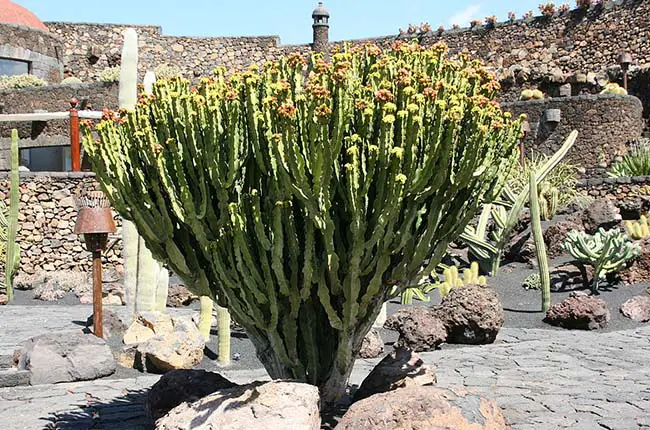
(Frank Vincentz, CC BY-SA 3.0, via Wikimedia Commons)
8. Blue Myrtle Cactus (Myrtillocactus geometrizans)
Named for its striking blue color, the Blue Myrtle Cactus has smooth skin and rounded, columnar tubercules with short thorns along vertical ridges. Tiny white or yellow flowers grow near the crown of each column in the summer.
While popular as a houseplant, the Blue Myrtle Cactus flourishes outdoors in USDA hardiness zones 9 – 11 and can grow up to 16.5 feet tall given the right conditions.
It also goes by the name Blue Candle Cactus.

(Frank Vincentz, CC BY-SA 3.0, via Wikimedia Commons)
9. Senita Cactus (Lophocereus schottii)
The Senita Cactus has columnar tubercules that branch out from the bottom, adding enough width to the plant to cover a window.
This smooth, virtually thornless cactus is ideal for families with small children, who might otherwise prick themselves on sharp cactus spines when playing outside.

(Consultaplantas, CC BY-SA 4.0, via Wikimedia Commons)
10. Baioensis (Euphorbia baioensis)
With needle-sharp spines and gray-green skin, Baioensis is a cactus with winding, snake-like tubercules that grow at the base and grow mainly upright, with larger ones bending and growing downwards due to weight.
The spines are white with red tips that turn black as the cactus grows older, giving the plant an attractive reddish tinge.
Indoors, Baioensis usually grows around 1 – 2 ft (30-60 cm) in height, but outdoors it grows much taller and can grow quite wide in a short period of time.
As with all Euphorbia species, Baioensis contains mildly toxic sap that can irritate the eyes and skin and cause sickness when ingested.
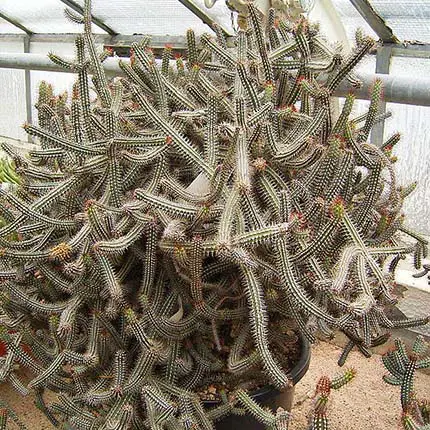
(Frank Vincentz, CC BY-SA 3.0, via Wikimedia Commons)
Fast-Growing Trailing/Spreading Succulents
Below are fast-growing succulents that are both large and have spreading or trailing parts. These parts can either be vines or tendrils – such as the Rattail Cactus – or the Crown of Thorns, which spreads out quickly with large, showy blossoms.
11. Crown of Thorns (Euphorbia milii)
The Crown of Thorns grows up to 6 feet tall (180cm) and 3 feet (90cm) wide, making it a large and attractive privacy hedge. It is known best for its bright red or pink flowers, which are unique in that they have two rounded overlapping petals.
This plant is low-maintenance and resistant to pests, flourishing at USDA hardiness zones 9 – 11.
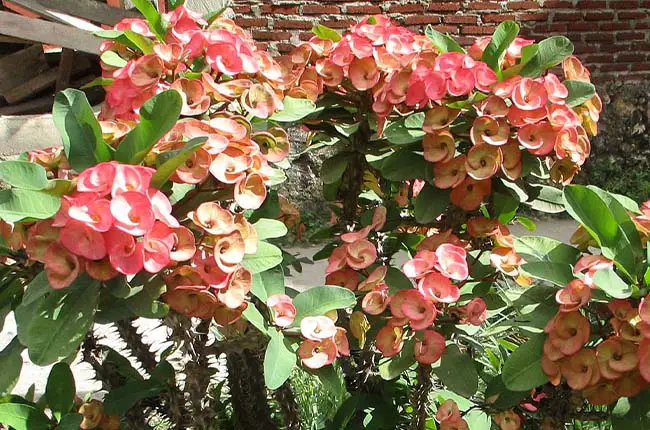
(David E Mead, CC0, via Wikimedia Commons)
12. Argentine Giant Cactus (Echinopsis candicans)
Known for its large, show-stopping white blooms, the Argentine Giant Cactus is native to South America and has thick, columnar stems that grow between 2 – 3 feet (60 – 90 cm) tall.
It spreads quickly for a cactus of its size and can grow into a clump that measures up to 10 feet (3 meters) across.
The flowers – the most well-known feature of this cactus – measure an impressive 8 inches (20 cm) across and are white and funnel-shaped. They attract pollinators such as bees, butterflies, and hummingbirds.
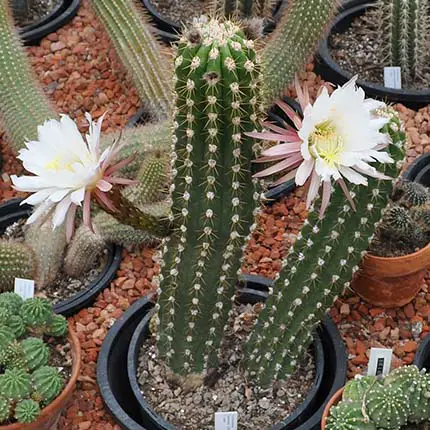
(Dig deeper, CC BY-SA 4.0, via Wikimedia Commons)
13. Prickly Pear Cactus (Opuntia spp.)
This well-known cactus includes over 100 subspecies and is known by several names, including the Beaver Tail Cactus, Rabbit Ear Cactus, and the Tree Cactus.
Its paddle-shaped cladodes (also called pads) spread like the branches of a tree.
As its name suggests, the Prickly Pear Cactus produces edible purplish-red fruit that is used in jellies, preserves, or enjoyed raw. During the spring and summer, this plant sprouts large, showy yellow, red, pink, or purple flowers.
The Prickly Pear Cactus has a wide distribution throughout the American Southwest and flourishes in USDA hardiness zones 7 – 10, making it an attractive choice for those who live in cooler climates where most cacti don’t grow well.

(Diego Delso, CC BY-SA 3.0, via Wikimedia Commons)
14. Rattail Cactus (Aporocactus flagelliformis)
With thin, bright green tendrils that can reach an impressive length of 4 – 6 feet (120-150 cm), the Rattail Cactus works ideally in a hanging basket and can easily cover glass patio or porch doors.
During the spring and summer, this plant has large, showy pink, red, or orange blossoms.
The spines are short and smooth, so this isn’t a prickly cactus. It is native to Central America and is ideal if you live in USDA hardiness zones 10 – 11.
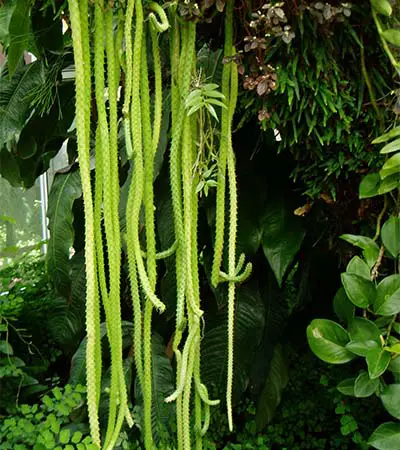
15. Eve’s Needle Cactus (Austrocylindropuntia subulata)
Native to the Peruvian Andes, Eve’s Needle Cactus – also called Eve’s Pin – is a unique cactus with dark green skin and rounded, curved tubercules.
Yellow-green, spiky leaves grow along the tubercules and curve inwards, growing up to 5 inches (13 cm) in length.
Eve’s Needle can grow very large, up to 15 ft outside in the right habitat. Like most cacti, this plant loves full sun and hot, dry climates.

(Frank Vincentz, CC BY-SA 3.0, via Wikimedia Commons)
Related
16 Fast-Growing Succulents For Ground Cover
26 Succulents With Spiky Leaves
14 Fragrant Succulents & Cacti
- Keiki Paste vs Rooting Hormone:What’s the difference? - February 4, 2024
- Top 10 Orchid Fertilizers: A Comprehensive Review (2024) - February 2, 2024
- Top 8 Soil Inoculants For Stronger Plants (2024) - February 1, 2024

